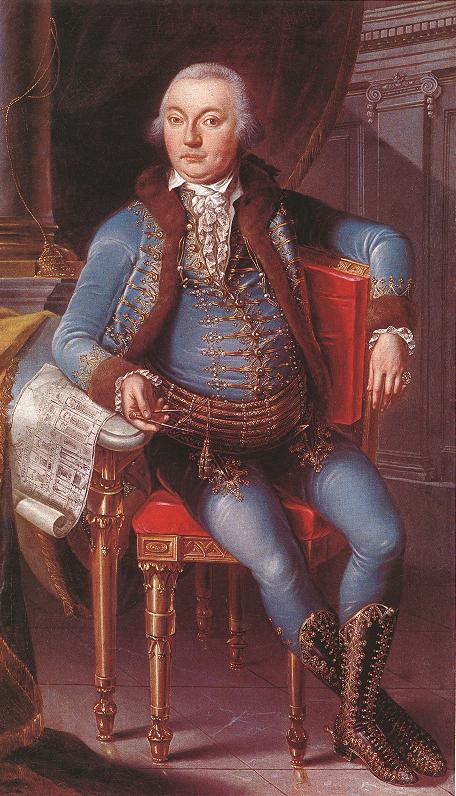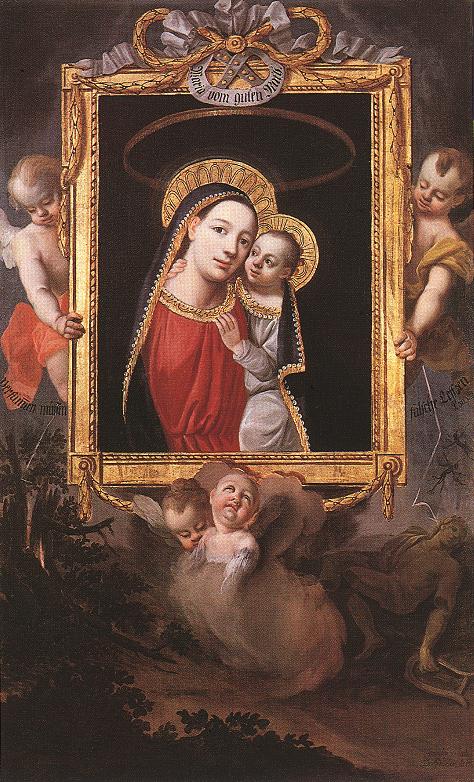Dorffmeister (Dorfmeister or Dorffmaister) István was a Hungarian painter of Austrian origin. He was a student of the Vienna Academy where he learnt his trade between 1751 and 1759. In 1760, at a very tender age he worked under Maulbertsch in Kromériz. In 1761 he was already in Hungary (Türje, murals in the Premonstratensian church). In 1762 he settled down in Sopron and worked until his death 35 years later almost exclusively for Hungarian patrons. Working in the tradition of Troger's school, he was the most prolific master of Hungarian Baroque painting, indeed the second most popular Baroque painter in the country after Maulbertsch. However, while Maulbertsch's primary patrons were leading members of the Hungarian clergy, Dorffmeister took commissions from everyone ranging from bishops through different monastic orders to town and village communities.
He painted the entire interior of several Transdanubian churches (Gutaöttös 1771-72, Császár 1775-76, Balf 1779, Nova 1779-80, Toponár 1781, Kiskomárom 1781, 1793, Sopron, Church of the Holy Spirit 1782, Szigetvár 1786). Elsewhere he painted only the chancel and the triumphal arch (Türje, 1761, 1763, Mesztegnyõ 1772, Kenyeri 1779, Kemenesszentpéter 1779, Kemenesmihályfa 2785, Nyul 1786, Gyóró 1793-94) usually together with altarpieces. He was employed by the lords of Transdanubian castles (Sárvár, Ligvánd, Füles, Hegyfalu, Alcsút), different monastic orders (Franciscans at Kismarton, Premonstratensians at Türje and Csorna, Benedictines at Celldömölk, Cistercians at Szentgotthárd), burghers of Sopron and the bishops of Pécs (László Esterházy) and, very often, of Szombathely (János Szily).
Dorffmeister's career reached its peak in the 1780s when, challenged by the Enlightenment and encouraged by the Hungarian nobles' movement against it, the leaders of Hungary's Catholic clergy assigned him to paint a whole series of monumental historical pictures, including churches' ceilings, altarpieces as well as panels for the reception rooms of bishops and abbots. (Battle of Szentgotthárd - Cistercian church, Szentgotthárd, 1784; The Fail and Retaking of Szigetvár - Parish church, Szigetvár, 1788; St. Stephen Founding the Abbey of Pannonhalma - Cathedral, Szombathely, 1791; Scenes from the History of the Abbey of Szentgotthárd - Abbot's reception room. Szentgotthárd, 1794-95). While these paintings were born in an ecclesiastical surrounding and according to the traditional artist-patron relationship, they still bore some fresh, modern meaning and became the representative works of new tendencies. The lay public of that time also reacted to those new tendencies, and thus Dorffmeister's late historical paintings became the forerunners and inspirers of 19th-century historical painting in Hungary.
//
![]()






